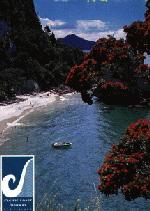|
 The
Coromandel Peninsula (Know locally as 'The Coromandel') lies in the
North Island of New Zealand. It is part of
the Waikato region and extends 85 kilometres north from the western end of
the Bay of Plenty, forming a natural barrier to protect the Hauraki Gulf and
the Firth of Thames in the west from the Pacific Ocean to the east. The
Coromandel Peninsula (Know locally as 'The Coromandel') lies in the
North Island of New Zealand. It is part of
the Waikato region and extends 85 kilometres north from the western end of
the Bay of Plenty, forming a natural barrier to protect the Hauraki Gulf and
the Firth of Thames in the west from the Pacific Ocean to the east.
At its broadest point, it is 40 kilometres wide. Almost the entire
population lies on the narrow strips along the Hauraki Gulf and Bay of
Plenty coasts. The country's biggest city,
Auckland, lies on the far shore of the
Hauraki Gulf, 55 kilometres to the west. The peninsula is clearly visible
from the city in fine weather.
The peninsula is steep and hilly, and is largely covered in subtropical rain
forest. The Coromandel Range forms a spine for the peninsula rising to
nearly 900 metres, and the large island of Great Barrier, which lies beyond
the northern tip, can be thought of as an extension of the range.
The Coromandel Range located in the middle of the Peninsula is crossed by
four roads linking the two coasts. South of the Coromandel Peninsula is the
Hauraki District, once swampy plain, now supports rich dairy farming land.
Gold mining history is perserved in the scenic Karangahake Gorge and the
towns of Waihi, Paeroa, and Ngatea.
Although the peninsula is close to large centres of population such as
Auckland to the west and
Tauranga to the southeast, its rugged
nature means that much of it is relatively isolated, and the interior and
northern tip are both largely undeveloped and sparsely inhabited. A forest
park covers much of the peninsula's interior.
Owing to the nature of the land, much of the Coromandel's population is
concentrated in a small number of towns and communities along the south
eastern and south western coasts.
Only five towns on the peninsula have populations of over 1000 (Coromandel,
Whitianga, Thames, Tairua, and Whangamata), and of these only Thames has a
population of over 5000. Several small towns dot the coast of the Firth of
Thames in the southwest. Other small towns on the peninsula include
Whiritoa, Hikuai, Pauanui and Colville.
The population of several of these centres is highly seasonal, with many
Aucklanders having holiday homes in the Coromandel. Around the Christmas and
New Year holiday period, the Coromandel is abuzz with activity, particularly
in Whangamata, Whitianga and Pauanui, where youths and families from around
the North Island come to spend their holiday.
The Coromandel is home to
conservationists, alternative lifestylers, craftspeople who live in the
towns of Thames, Coromandel, Whitianga and Whangamata.
The towns, all with heritage trails, local museums are of historical
interests with fine Victorian buildings and relics of the gold mining and
kauri logging days.
The Coromandel is served by various bus and coach operators providing regular
daily services from Auckland, Hamilton Rotorua and Tauranga and by air with
Air Coromandel from Auckland, Great Barrier Island and Tauranga.
There are no passenger train or rail services to or from the Coromandel
Peninsula.
The nearest airports for domestic air services is
Tauranga and
Auckland and
for international air services is
Auckland. |
 The
Coromandel Peninsula (Know locally as 'The Coromandel') lies in the
The
Coromandel Peninsula (Know locally as 'The Coromandel') lies in the